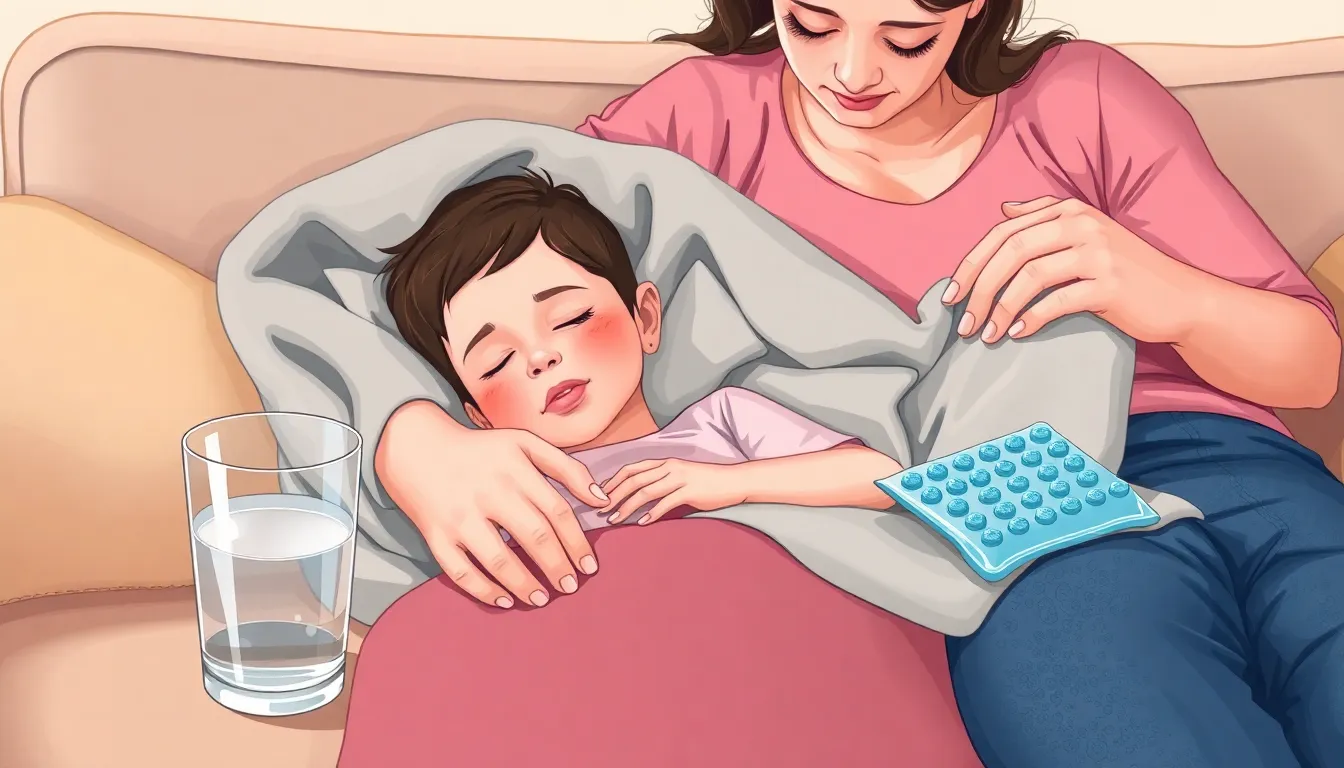When a child runs a fever, it can feel like a scene straight out of a dramatic movie—parents pacing the floor and kids looking like they just stepped off a rollercoaster. But fear not! Lowering a child’s fever doesn’t require a PhD in medicine or a magic wand. With a few tried-and-true methods, parents can bring the temperature down while keeping their little ones comfortable and happy.
Table of Contents
ToggleUnderstanding Fever in Children
Fever often presents a challenge for parents. Recognizing its nature and underlying causes helps in appropriate management.
What Is Fever?
Fever signifies an increase in body temperature, typically over 100.4°F (38°C). It acts as an immune response, defending against infections. Commonly, temperatures may fluctuate throughout the day, often rising at night. Accurate measurement requires a reliable thermometer, with digital ones providing quick results. Understanding fever helps demystify a child’s symptoms, guiding parents in effective care.
Common Causes of Fever in Children
Infections often lead to fever in children, including viral and bacterial types. Flu, cold, and ear infections are prevalent examples. Other causes may include immunizations, inflammatory conditions, and dehydration. Teething might also result in slight temperature elevations. Knowing the specific triggers aids parents in gauging when to seek medical attention.
Effective Methods to Reduce Fever

Managing a child’s fever involves various effective methods that can help reduce temperature and enhance comfort. Parents can choose from home remedies or consider over-the-counter medications as viable options.
Home Remedies
Hydration plays a crucial role in fever management. Parents should ensure their child drinks plenty of fluids, such as water, clear broths, and electrolyte solutions. A lukewarm bath can also help lower body temperature; aim for comfortable warmth, avoiding cold water. Lightweight clothing keeps the child cool, while a gentle fan may increase airflow. Additionally, cool compresses placed on the forehead or wrists can provide immediate relief. These simple remedies often prove effective in alleviating fever symptoms, while prioritizing the child’s comfort.
Over-the-Counter Medications
Various over-the-counter medications effectively lower fever in children. Acetaminophen serves as a common choice, suitable for infants over two months old, while ibuprofen is recommended for children older than six months. Dosage depends on the child’s weight; therefore, parents should follow label instructions or consult a healthcare professional. Avoid giving aspirin due to the risk of Reye’s syndrome. Monitoring temperature regularly after administering medication can help assess effectiveness. These medications, combined with other methods, enhance comfort and promote recovery.
When to Seek Medical Attention
Recognizing when to seek medical attention for a child’s fever is crucial for their health. Parents should observe specific signs of a severe illness that could require immediate care.
Signs of Severe Illness
High fever exceeding 104°F (40°C) prompts action. Difficulty breathing, persistent vomiting, or severe headache indicates potential complications. Parents should note signs of lethargy or a rash that doesn’t fade under pressure, which may signal serious conditions. If a child shows a stiff neck or develops seizures, urgent medical attention is essential. Any unusual irritability or inability to wake could suggest a more severe underlying issue.
Consulting a Healthcare Professional
Consulting a healthcare professional benefits parents facing uncertainty. When fever lasts more than three days, it’s advisable to seek advice. Professional guidance is necessary if the child has a pre-existing condition or is under two months old with any fever. Medical professionals can offer tailored recommendations and may perform diagnostic tests. Trust in their expertise helps address any concerns effectively and ensures the child’s health remains a priority.
Tips for Managing Fever at Home
Managing a child’s fever at home involves simple yet effective strategies. Ensuring the child’s comfort remains a top priority while implementing these techniques.
Keeping Your Child Comfortable
A comfortable environment helps lower a child’s fever. Dress the child in lightweight clothing to prevent overheating. Keep room temperatures cool yet cozy, using fans or air conditioning as necessary. Lukewarm baths can also provide relief, as they help reduce body temperature without causing shivering. Using cool, damp cloths on the forehead, wrists, and feet can enhance comfort. Pay attention to the child’s behavior; if they seem restless or uncomfortable, additional measures may be required.
Hydration and Nutrition
Fever increases fluid loss, making hydration crucial. Encourage the child to drink plenty of water, electrolyte solutions, or clear broths. Offering small sips can make it easier, especially if the child’s appetite decreases. Fruit juices can also provide hydration while delivering calories when appetite is low. Nutrient-rich foods like soups, applesauce, or ice pops can help with hydration and nourishment. Maintaining hydration supports the body’s immune response, assisting in recovery during a fever. Regularly checking for dehydration signs, such as dry mouth or reduced urine output, ensures the child remains healthy.
Managing a child’s fever can be challenging but with the right approach parents can ensure their child’s comfort and well-being. By staying informed about fever’s nature and causes parents can confidently take steps to alleviate symptoms.
Hydration and comfort are key components in this process. Simple methods like lukewarm baths and lightweight clothing can make a significant difference.
It’s crucial to remain vigilant for any concerning signs that may require medical attention. By combining home care strategies with professional guidance when necessary parents can effectively support their child’s recovery during a fever.


